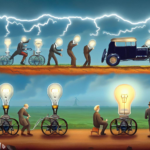Introduction
Innovation is a term that’s often thrown around in today’s rapidly changing world. From technology to business and beyond, innovation is hailed as a key driver of progress. But what exactly is innovation, and how has its definition evolved over time? In this blog post, we will delve into the fascinating journey of innovation, emphasizing key elements that have shaped its ever-evolving concept.

How has Innovation Evolved Over Time?
- Historical Roots of Innovation: To understand the evolution of innovation, we must first travel back in time. Innovation traces its roots to ancient civilizations. Inventions like the wheel, printing press, and steam engine were groundbreaking innovations that transformed societies. These innovations were primarily focused on creating new tools and systems to enhance human life.
- Industrial Revolution and Technological Advancements: The 18th and 19th centuries marked a significant turning point in the history of innovation. The Industrial Revolution brought about mass production, powered by innovations in machinery and manufacturing processes. This era introduced the concept of continuous improvement, a precursor to modern innovation practices.
- The Birth of Modern Innovation: The 20th century witnessed a shift in how we perceive innovation. It moved beyond just inventing new things to encompass processes, services, and business models. The term “innovation” began to encompass a broader spectrum of creative progress, focusing on improving efficiency and meeting evolving consumer needs.
- Digital Revolution and Technological Convergence: The late 20th and early 21st centuries ushered in the digital revolution, leading to unprecedented technological advancements. Innovations in computing, telecommunications, and the internet transformed the way we live and work. This era saw innovation intertwined with information technology, giving rise to startups and disruptors that challenged traditional industries.
What is Innovation in Evolution?
- Dynamic Adaptation: One key element of innovation’s evolution is its dynamic nature. Innovation adapts to the times, reflecting the needs and aspirations of society. It’s not a static concept but a fluid, ever-changing force that responds to challenges and opportunities.
- Expanding Horizons: Over time, innovation has broadened its horizons. It’s no longer confined to product development; it encompasses processes, services, and even social innovations. Innovations in business models, such as the sharing economy, demonstrate this expansion.
The History of Innovation
- Innovation in Ancient Times: As mentioned earlier, innovation dates back to ancient civilizations. The innovation of tools and techniques was driven by the need for survival and progress.
- The Renaissance and Enlightenment: The Renaissance and Enlightenment periods in Europe fostered an environment of intellectual exploration and innovation. Thinkers like Leonardo da Vinci exemplified innovation across art and science.
- The Industrial Age: The Industrial Age, marked by inventions like the cotton gin and steam engine, revolutionized manufacturing and transportation. This era laid the groundwork for modern industrial innovation.
- The Digital Age: The digital age has seen innovations like the personal computer, internet, and smartphones. These innovations transformed how we communicate, work, and access information.
Example of Evolution of Innovation
One prominent example of the evolution of innovation is the automotive industry. Initially, innovation in this sector focused on improving the mechanics and efficiency of vehicles. However, over time, innovation shifted towards environmental concerns, giving rise to electric and hybrid vehicles. Moreover, the concept of “smart” cars with advanced connectivity and autonomous driving capabilities represents the latest frontier of innovation in the automotive sector.
TO NOTE
- Innovation has evolved from ancient toolmaking to encompass a wide range of concepts, including processes, services, and social innovation.
- The Industrial Revolution played a pivotal role in shaping modern innovation practices.
- The digital age and technological advancements have expanded the scope of innovation.
- Innovation is dynamic and adaptive, responding to changing societal needs.
Conclusion
Innovation is a concept that has evolved significantly over time, reflecting the changing needs and aspirations of society. From its humble beginnings in ancient civilizations to the dynamic, technology-driven force it is today, innovation has come a long way. Understanding its evolution is crucial for individuals and organizations seeking to harness its power for a better future.
In the ever-changing landscape of innovation, staying adaptable and open to new ideas is key. As we continue to push the boundaries of what is possible, innovation will remain a driving force in shaping our world.
References:







